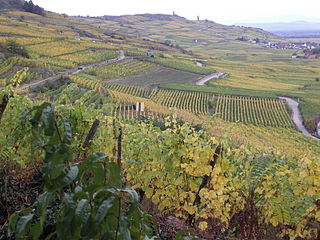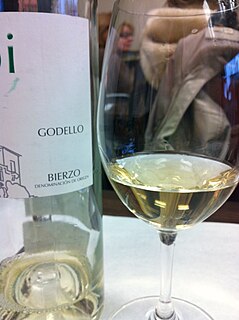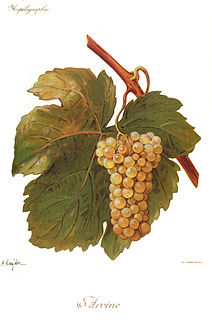
Syrah, also known as Shiraz, is a dark-skinned grape variety grown throughout the world and used primarily to produce red wine. In 1999, Syrah was found to be the offspring of two obscure grapes from southeastern France, Dureza and Mondeuse Blanche. Syrah should not be confused with Petite Sirah, a cross of Syrah with Peloursin dating from 1880.

Mauzac or Mauzac blanc a white variety of grape used for wine, of the species Vitis vinifera. It is mainly grown in the Gaillac and Limoux regions in the southwest of France. Total French plantations of Mauzac stood at 3,200 hectares in the year 2000.

Trockenbeerenauslese is a German language wine term for a medium to full body dessert wine.

Alsace wine or Alsatian wine is produced in the Alsace region in France and is primarily white wine. Because of its Germanic influence, it is the only Appellation d'Origine Contrôlée region in France to produce mostly varietal wines, typically from similar grape varieties to those used in German wine. Along with Austria and Germany, it produces some of the most noted dry Rieslings in the world as well as highly aromatic Gewürztraminer wines. Wines are produced under three different AOCs: Alsace AOC for white, rosé and red wines, Alsace Grand Cru AOC for white wines from certain classified vineyards and Crémant d'Alsace AOC for sparkling wines. Both dry and sweet white wines are produced.

Müller-Thurgau is a white grape variety which was created by Hermann Müller from the Swiss Canton of Thurgau in 1882. It is a crossing of Riesling with Madeleine Royale. It is used to make white wine in Germany, Austria, Northern Italy, Hungary, England, Australia, the Czech Republic, Slovakia, Slovenia, New Zealand, Canada, the United States and Japan. There are around 42,000 hectares (104,000 acres) cultivated worldwide, which makes Müller-Thurgau the most widely planted of the so-called "new breeds" of grape varieties created since the late 19th century. Although plantings have decreased significantly since the 1980s, as of 2006 it was still Germany's second most planted variety at 14,000 hectares and 13.7% of the total vineyard surface. In 2007, the 125th anniversary was celebrated at the Geisenheim Grape Breeding Institute. Müller-Thurgau is also known as Rivaner, Riesling x Sylvaner, Riesling-Sylvaner (Switzerland), Johannisberg, Rizvanec (Slovenia) and Rizlingszilváni (Hungary).

Scheurebe or Sämling 88 is a white wine grape variety. It is primarily grown in Germany and Austria, where it often is called Sämling 88, and some parts of the New World. Scheurebe wines are highly aromatic, and the variety is often used for sweet wines, although dry Scheurebe wines have become more common in Germany.

Godello is a white variety of wine grape grown in northwestern Spain, in particular in Galicia. The Gouveio found in northern Portugal is thought to be the same grape variety.

Swiss wine is produced from nearly 15,000 hectares of vineyards, and the wines are mainly produced in the west and in the south of Switzerland, in the cantons of Geneva, Neuchâtel, Ticino, Valais and Vaud. White grape varieties are grown on 43% of the country's vineyard area, and red grape varieties on 57%.
Courbu is the name of three different, but related varieties of wine grapes primarily found in South West France. All are Vitis vinifera grapes. The name Courbu, without suffix, can refer to both Petit Courbu and Courbu blanc, and not all sources differ between the two.

Petite Arvine is a white wine grape planted in the Valais region of Switzerland. Total Swiss plantations of the variety in 2009 stood at 154 hectares.
Azal branco is a white Portuguese wine grape planted primarily in the Minho region but with greater expansion to Amarante, Basto, Baião and Vale do Sousa sub-regions. It noted for the high acidity of its wines, and is used for white Vinho Verde. Varietal Azal Branco wines can be somewhat reminiscent of Riesling.
Completer or Malanstraube is a white Swiss wine grape variety grown primarily in eastern Switzerland around Graubünden. The Completer vine was once domesticated but has now become mostly feral though some Swiss winemakers will make limited quantities of wine harvested from the wild vines. Wine produced from Completer tends to be very full bodied and aromatic.
Erbaluce or Erbaluce bianca is a white Italian wine grape grown primarily in the Piedmont region around Caluso, in Canavese. In addition to dry table wines, it is used to make sweet wines with deep golden coloring, such as passito. The grape has a long history in the Piedmont region, with the first written record dating to 1606, and most likely originated in the alpine hills of northern Piedmont.
Humagne Blanche or Humagne is a white Swiss wine grape planted primarily in the Valais region. The total Swiss plantations of the variety in 2009 stood at 30 hectares.
Limnio (LIM-nee-oh) is a red Greek wine grape variety that is indigenous to the Greek island of Lemnos. The grape has had a long history of wine production that may extend back to Ancient Greece with wine historians widely believing it was the grape variety, Lemnia, that was described by Aristotle as producing the famous red Lemnian wine. According to wine expert Oz Clarke, Limnio is "One of Greece's most important red vines."
Gamaret is a variety of red wine grape. It was created by André Jaquinet at Station Fédérale de Recherches en Production Végétale de Changins in 1970 by crossing Gamay and Reichensteiner. Gamaret was developed for cultivation in French Switzerland, and is a full sibling of Garanoir, which was intended for the German part of the country.
Garanoir is a variety of red wine grape. It was created by André Jaquinet and Dominique Maigre at Station Fédérale de Recherches en Production Végétale de Changins in 1970 by crossing Gamay and Reichensteiner. Garanoir was developed for cultivation in German Switzerland, and is a full sibling of Gamaret, which was intended for the French part of the country.
Cornalin d'Aoste or Humagne Rouge is a variety of red wine grape. It was named after the Aosta Valley in northwestern Italy where it was wrongly presumed to have originated, but where it is now almost extinct. It is primarily grown in the Valais region in Switzerland, where it is called Humagne Rouge, and the total Swiss plantations of the variety in 2009 stood at 128 hectares. The wines produced from the variety are wild, rustic and high in tannin.
Rouge du Pays, also known as Cornalin du Valais or Cornalin, is a variety of red wine grape. It is primarily grown in the Valais region in Switzerland, where it is often called Cornalin, and the total Swiss plantations of the variety in 2009 stood at 116 hectares. It produces deep-coloured wines that typically need aging, and is something of a speciality of Valais.

Olmo grapes are wine and table grape varieties produced by University of California, Davis viticulturist Dr. Harold Olmo. Over the course of his nearly 50-year career, Dr. Olmo bred a wide variety of both grapes by means of both crossing varieties from the same species or creating hybrid grapes from cultivars of different Vitis species.









